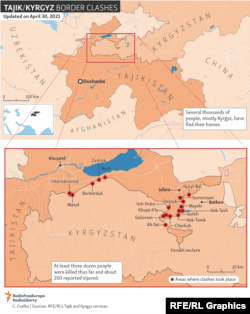BISHKEK -- Kyrgyzstan and Tajikistan have completed the withdrawal of their military units from border areas as part of an agreed pullback following a series of deadly clashes last week.
The Kyrgyz Border Service said on May 3 that the situation in the area is calm and stable after the withdrawal of the military units.
"The sides have completed the withdrawal of additional military units and equipment from the border.... The joint military commission consisting of officers from the defense structures of Kyrgyzstan and Tajikistan continue inspecting the areas left by the additional military forces and equipment," the Border Service statement said.
On May 2, the head of Tajikistan's State Committee for National Security, Saimumin Yatimov, said while visiting the country's Vorukh exclave within Kyrgyzstan that Tajik military forces had been withdrawn from the border.
Kyrgyzstan says that during the April 28-29 clashes, 36 Kyrgyz citizens were killed, including a 5-year-old boy, 183 were injured, and 50,000 people fled the area.
According to Bishkek, 78 private homes, two schools, one medical point, two border checkpoints, a kindergarten, 10 gasoline stations, a police building, and eight shops were destroyed in Kyrgyzstan's southwestern region of Batken.
While the situation on the ground appeared calmer, moves behind the scenes threaten to keep tensions simmering.
The Tajik Prosecutor-General's Office said on May 3 that it had launched a probe against a group of Kyrgyz military personnel, accusing them of "instigating or conducting an aggressive war," and the "murder of two or more people while carrying out their duties."
In a statement, the prosecutor claimed that Kyrgyz border guards incited Kyrgyz villagers to throw stones at Tajik workers involved in the "agreed" installation of surveillance cameras at a water-distribution point near Tajikistan's Vorukh exclave within Kyrgyz territory. It added that they also tried to cut down a pole upon which a Tajik worker was perched as he was installing a camera.
The statement comes a day after the Kyrgyz Interior Ministry said it had launched 11 criminal cases into "mass disorder, crimes against peace, hooliganism, the destruction and damage of private property, Illegal border crossings, and murder."
The Committee for Emergencies in Tajikistan's northern Sughd region said on May 3 that during the clashes, 14 private houses were destroyed, while two houses and a maintenance building were damaged in three neighborhoods of the city of Isfara.
According to the committee, a school building and a private house were partially damaged in the village of Ovchikalacha in the Bobojon Gafurov district.
The statement did not mention human losses.
However, correspondents from RFE/RL's Tajik Service in the area have reported that at least 16 Tajik nationals were killed and at least 90 were injured.
The violence apparently followed a dispute over the installation of surveillance cameras at a water distribution point near the Vorukh exclave, drawing in security forces from both countries.
Kyrgyz security officials at one point accused Tajik forces of using MI-24 helicopter gunships to shoot at Kyrgyz villages.
The meeting of the Tajik and Kyrgyz delegations followed a telephone conversation between Kyrgyz President Sadyr Japarov and his Tajik counterpart, Emomali Rahmon.
The European Union, the Organization for Security and Cooperation in Europe, and Russia have all urged both sides to respect the cease-fire agreement.
Both Kyrgyzstan and Tajikistan host Russian military bases.
Human Rights Watch has called for an immediate investigation to hold either side responsible for laws-of-war violations against civilians.
Like many other border areas in Central Asia, almost half of the 970-kilometer-long Kyrgyz-Tajik border has not been demarcated, leading to tensions for the past 30 years.













